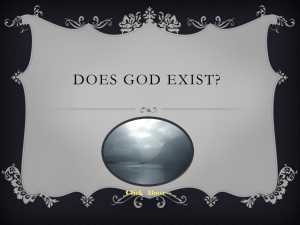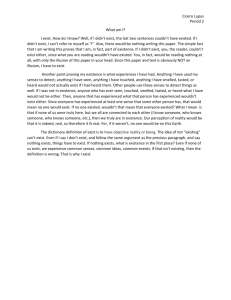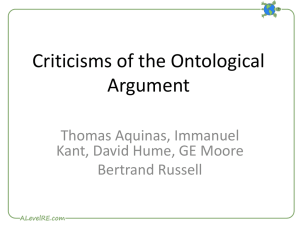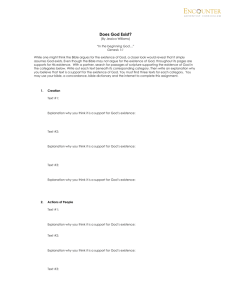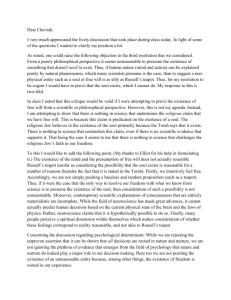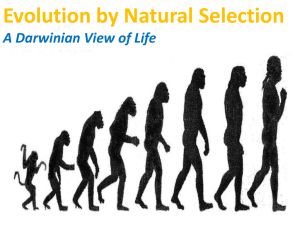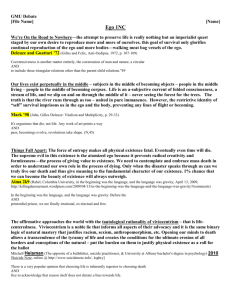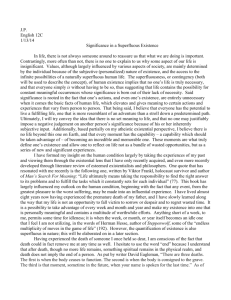Ludwig 1950. On the
advertisement
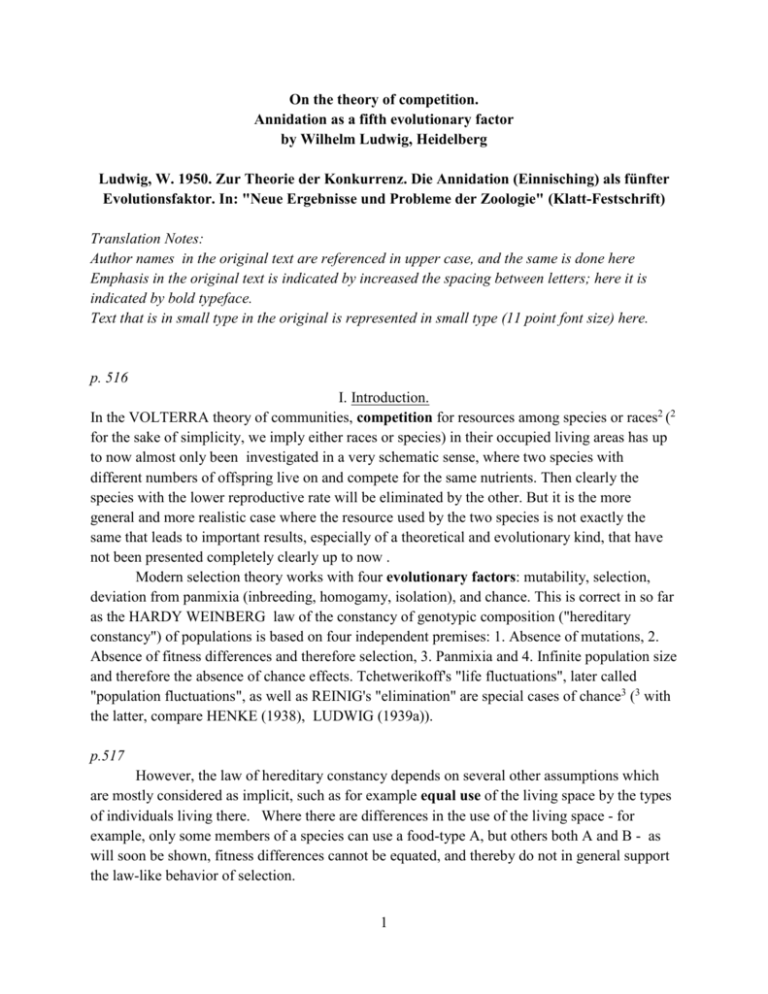
On the theory of competition.
Annidation as a fifth evolutionary factor
by Wilhelm Ludwig, Heidelberg
Ludwig, W. 1950. Zur Theorie der Konkurrenz. Die Annidation (Einnisching) als fünfter
Evolutionsfaktor. In: "Neue Ergebnisse und Probleme der Zoologie" (Klatt-Festschrift)
Translation Notes:
Author names in the original text are referenced in upper case, and the same is done here
Emphasis in the original text is indicated by increased the spacing between letters; here it is
indicated by bold typeface.
Text that is in small type in the original is represented in small type (11 point font size) here.
p. 516
I. Introduction.
In the VOLTERRA theory of communities, competition for resources among species or races2 (2
for the sake of simplicity, we imply either races or species) in their occupied living areas has up
to now almost only been investigated in a very schematic sense, where two species with
different numbers of offspring live on and compete for the same nutrients. Then clearly the
species with the lower reproductive rate will be eliminated by the other. But it is the more
general and more realistic case where the resource used by the two species is not exactly the
same that leads to important results, especially of a theoretical and evolutionary kind, that have
not been presented completely clearly up to now .
Modern selection theory works with four evolutionary factors: mutability, selection,
deviation from panmixia (inbreeding, homogamy, isolation), and chance. This is correct in so far
as the HARDY WEINBERG law of the constancy of genotypic composition ("hereditary
constancy") of populations is based on four independent premises: 1. Absence of mutations, 2.
Absence of fitness differences and therefore selection, 3. Panmixia and 4. Infinite population size
and therefore the absence of chance effects. Tchetwerikoff's "life fluctuations", later called
"population fluctuations", as well as REINIG's "elimination" are special cases of chance3 (3 with
the latter, compare HENKE (1938), LUDWIG (1939a)).
p.517
However, the law of hereditary constancy depends on several other assumptions which
are mostly considered as implicit, such as for example equal use of the living space by the types
of individuals living there. Where there are differences in the use of the living space - for
example, only some members of a species can use a food-type A, but others both A and B - as
will soon be shown, fitness differences cannot be equated, and thereby do not in general support
the law-like behavior of selection.
1
The existence of this kind of difference and the outcome of the resulting competition shed
light onto important and long-standing questions of evolution: the origin of species in the same
location, the stable occurrence of related species in the same living space, and the origin of
maladaptive or neutral characteristics. These considerations will lead to the addition of a fifth
evolutionary factor "Einnischung", or Annidation to those we already know.
II. The concepts of "fitness" and "selection"
We speak of selection when out of two competing races or species, the one with the
lower relative fitness is gradually eliminated. Here, fitness is defined as follows: If two races R
and R' with N and N' numbers of individuals live in the same infinite and isolated living space
and if the ratio N:N' decreases from one generation to the next on average to N(1-k):N', where
k>0, then race R' will have the higher fitness. The quantity k is called the relative fitness of R'
with respect to R, or fitness difference for short4 (4 because of the small size of k, we have the
relation (1-k):1 ≈ 1:(1+k).). It is easy to see that the ratio of the two population sizes will
become always more extreme. Now because the finite and limited resources in the long term
only support a certain number of individuals, so N+N' cannot exceed a certain high value N*,
then the race with the lower fitness will be gradually eliminated.
The fitness difference k can come about in two ways. Either R' has a higher reproductive
rate (multiplication rate) than R, and otherwise both races do not differ.
p. 518
Or both have the same reproductive rate, but R' has an advantage in some way over R in the
struggle for existence. In the latter sense, thus considering two races with the same reproductive
rate, one says that R' has a selective advantage ofer R of k5 (5 this definition of advantage
corresponds with that of Haldane. With regard to other definitions of advantage cf. Ludwig
(1939b). Obviously both can be the case, and thus it follows right away that on one hand a
positive k has an effect through a higher reproductive rate and on the other hand that it can be
compensated for by a lower number of descendants.
Three things are therefore characteristic of selection:
1. Selection results in the elimination of races of lower fitness. A stable equilibrium between
races of differing fitness is only possible when other forces (mutation pressure, immigration)
work against selection.
2. Each positive selective advantage is equal in its effect on increasing the multiplication rate and
can only be compensated for by a reduction in the latter.
3. A newly arisen selectively neutral trait can on average, i.e. without chance effects, only
increase in a population if it is absolutely linked with an advantageous trait, such as for example
when both characters are affected by the same allele; this is without considering rare mutation
pressure. The same is true for deleterious characters.
III. Accidental, eaten, and shortage fractions
2
From the young individuals of a species, only a small proportion come to successful
reproduction, the rest dying beforehand. The latter proportion of all offspring we call the
probability of mortality rate or the mortality rate v. It is, if the population number remains
constant, and n is the number of offspring, (n-1)/n.
As presented briefly by the author in another place (1939b), mortality can be classified
into three groups. Mortality from:
a) Accident, i.e by abiotic influences (accident especially, cold, drought, etc.), through disease
(here distinguished from what in b is classified as cases of parasitism), failure to survive
metamorphosis, birth, etc. This proportion of juvenile forms dying due to chance effects we will
call the accident fraction.
b) Being Eaten, i.e. mortality due to natural enemies (predators; macroparasites, microparasites
with intermediate hosts): eaten fraction
c) Shortage of resources, e.g. food, oxygen, habitat (reproductive space, mating, nest or
overnight resting sites, territories ["reviere"] (for example for the large mammals in Africa),
being a host for parasites, heating material for people (Peru) etc.; shortage fraction.
The sum of the accident, eaten and shortage fractions is the mortality rate.
The accident fraction of a species can be independent of the population size, and,
because overpopulated habitat will hardly be considered in the following, also independent of the
population density, and therefore from now on it will be considered as constant.
With the eaten fraction, the only consideration is that a prey lives in equilibrium with its
enemies, or a predator with its prey. After the considerations of Volterra it can be assumed that
the population size of each species will vary about a mid-point, so that the eaten fraction can also
be seen as constant overall. Furthermore, in general in Volterra's considerations only the
population sizes N are included, not the densities, so the eaten fraction can be considered as
independent of the population density.
The role of the shortage fraction will be explained in the next section. In contrast to
accidental and eaten fractions, it certainly depends on the population density.
IV. The role of the shortage fraction. The shortage factor.
With the shortage factor the critical "life factor" in the living area is that which is the
scarcest. It is called the shortage factor. As a result of its limited quantity, in the living space
over a period of time, only a certain maximum number N* of individuals of a particular species
can exist. We say that the habitat provides this species with N* existence spaces.
If a population finds itself in equilibrium in a habitat, its average population size N will
remain constant. For this number N, the accident, eaten, and shortage fraction can be determined.
Thus at the outset it is improbable that the accident fraction prevents the further increase in N,
except (mathematically speaking; infinitely) in the improbably case when it is as big as to on
average leave exactly two progeny per pair. For the schematic case of goat-wolf it means that
the population number of goats Nz will increase after removal of the wolves, till through a
shortage of resources it will increase further to a certain value of Nz*. Considering there is an
3
additional limiting factor for sheep, let us call it "cabbage", leads to a consideration of the three
species system cabbage-goat-wolf, even without mathematical considerations to the result that
the numbers of goats (Nz) as well as wolves (Nw) are determined by the shortage factor of
cabbages (Nk): with declining Nk, Nz and Nw also decline, till finally Nw = 0, i.e. till cabbage still
only is enough for the existence of the goats but not the wolves. This situation is also dealt with
in Volterra's theory (cf. D'ANCONA, Ch. XX): in a habitat, wolves, sheep and goats live in
certain resource conditions, and depending on the relationships of particular constants, this can
maintain all three species, or wolves die out, or finally the two animal species. For what follows
it is relevant that for population number and density all the inhabitants of a habitat are
eventually dependent on the available shortage ratio. The strengths of predatory as well as all
species that have no natural enemies6 (not including disease causing bacteria etc. whose effects
occur in the accidental and not in the scarcity proportion) would be direct , which the prey
species or other species with natural enemies would be indirectly determined or co-determined
by the scarcity fraction.
Even so the VERHULST-PEARL equation, which describes population growth of a
species under limited resources and has been frequently verified, is based on the assumption of a
limited number of existence places and a shortage fraction. The equation expands the meaning
given by the author (1928) and later by GAUSE (1932):
{Population growth during dt} is proportional to {number of yound individuals produced during
dt} X {number of existence places still free}
(Eq.1)
where the latter factor in the brackets (by inclusion of the constant c) can be converted to
"probability of finding a new existence place".
Relationship Eq. 1 can be expressed as
dN = c . N ε dt . (N* - N).
(Eq. 1a)
Thus for N = N* when all the existence places are occupied, dN = 0, and c = 1/N*, and 1(a)
becomes the ususal form of the VERHULST-PEARL equation.
p. 521.
(1/N) (dN/dt) = ε (1-(N/N*))
(Eq. 1b)
Thus the role of resource shortage can be shown to be critically important. A few further remarks
can also be added.
Assume for example that one is dealing with a herbivore such as a rodent with very important
enemies, and that food is an important factor. The number of existence places N*will probably be
determined mainly by the resources available during the winter. Moreover one can suggest that when all
the existence places are occupied, also all winter food will be exhausted, so that to a certain degree N*
would be as if in the harshest times the available food for each animal would be the minimum necessary
4
to sustain it. Many more would die of this because they would by chance find themselves without food,
and conversely for the same reasons a certain amount of food will remain unused. If the living space in
food density very small then often there no individual would be able to survive for the duration - N*
becomes 0 - as well the total food quantity for some individuals would be exhausted.
It can be further added that the VERHULST-PEARL also applies to humans (PEARL). N* is the
number of "places" that an individual requires to provide living needs. For example, that the reproductive
rate of man responds to any decline in "free spaces", such as with unemployment, is clearly manifest and
widespread in the post-war statistics, in spite of the many sided complications by secondary factors.
V. Ecomutations
In the animal kingdom we know of many ecological differences between closely related
species. One thinks of the food specialization of many insects and their larva or of the host
specialization of gall forming insects and above all of parasites. These differences are at least
mostly inherited and must have arisen, in terms of what one knows about speciation, via
mutations. That he mutations themselves - we will call them ecomutations - have hardly been
observed is understandable. After all inherited differences between races are already known, e.g.
in plants (Turesson-Lyssenko) and in some situations its Mendelian basis is established, as for
the preferred temperature regime by warm blooded animals (Herter) or for the duration of
dormancy in tent moths [gypsy moths?] (Goldschmidt). Above all it is feasible that many
morphological differences have ecological effects. Longer tongues in insects [Schwaermen]
makes it possible for them to visit deeper nectaries. Increase in size or changes in the shape of
mouth parts will have the effect of changing the available resources; with a more pronounced
proboscis
p. 522
thick surfaces, whether in plants or animals, can be penetrated. Smaller body sizes makes new
niches and hiding places accessible and thereby also new food sources, while other advantages
may accrue from smaller body sizes. Smaller hosts are good for smaller parasites, such as an
aphid for the smallest parasitoid wasps. An increase in the hemoglobin concentration - it would
be the morphological mutation - would enable chironomid larvae to reach areas of lower oxygen
concentration and thereby establish new existence places. These examples could be repeated.
We consider now ecomutations that act on the shortage factor. It is useful to consider
a schematic case. A species is living in a closed habitat; if the number of individuals is N* all
existence places would thus be occupied. One is dealing with a predator that itself has no
enemies, or a "social" insect. The major factor determining N* will be food. Now a mutant
could occur that makes available another food source such that for this race (if it alone is present)
the number of existence places is increased in the habitat under consideration from N* to
N*+R*. For notational convenience, we will call the mutant diphagous, and the wild type
monophagous. From this various things follow that are more or less self evident:
5
1. Both food types, the new and the old, can be accessed by any of the diphagous species. This
race can therefore live alone on the new food. Moreover it has no preference for one food type over the
other.
2. Because in the animal kingdom food preferences are generally determined instinctively, the
diphagous individual must have the instinct to eat the new food as well as the ability to use it. Because the
species can already have one or the other the mutation needs only to occur in one trait or the other.
3. It follows that because the R* new existence places actually increases the number of
individuals from N* to N*+R*, it follows that if another scarcity factor does not come into play, that the
indeed more than N* but smaller than N*+R* existence places remain for each, which so to say they
occupy second place in the hierarchy of shortage factors [need to work on this sentence]. In such cases the
population size can only increase to the values described by this factor. Because this only means a
modification but no basic change to the question being considered here, such possibilities can be excluded
from consideration.
4. The new food shall be sufficiently specific that it will not bring the new mutant in competition
with any other species (this premise will be relaxed later).
p. 523
Such a mutation results in a change from stenophagy to euryphagie. For all other
ecological characters, it is possible to think of mutations that lead from steno- to euryphagie. In
this regard we speak from now on of the "monoicous" species and the "dioicous" mutants. The dioicous
individuals thus occupy an up to now unused niche of the habitat - this word being understood in the
sense of ELTON. A symbolic representation is given in Fig. 1a: scattered among the pre-existing
existence places are found R* more which up to now have not been filled. A species which in this sense
through a mutation becomes euryoicous does not increases its living space from the outside inwards, in
that its living area becomes larger, but from the inside. Mone things of , e.g., of a chironomus larva
which because of a certain increase in the carrying capacity of hemoglobin can work its way deeper int ot
he mud and so can also live on the food found there (shortage factors could equally be food or space. Fig.
1 b).
What will be shown in the following is above all that those mutations that increase the
number of existence places do not follow the rule-like laws of selection. These mutations will
usually spread more quickly, also when they have an arbitrary selective advantage, as long as
they are at minimally viable. The advantage of dioicous races can thus not be compensated for
by a selective advantage (more exactly: never completely). This can be explained by a brief
example. In a habitat there are wolves, goats and sheep. Wolves only like to eat goats, and
moreover sheep and goats do not compete. A new wolf race now arises by mutation which eats
sheep in addition to goats. Even when this diphagous wolf reproduces much less than the
original monophagous race, if it for example is less cold-tolerant or by is less able to catch prey
as well s the other species, it will, in so far as
p. 524
it is present and viable, in that it can reproduce itself and not die out by itself, increase steadily
in numbers, because the sheep will not be taken as a food source by anything else, to a specific
value determined by food shortage. Additionally, these diphagous wolves, even though they less
6
capable than the monophagous one, will still like to kill and eat a goat, and so the population
numbers of the original race will fall to an equilibrium between it and the new race in which all
the living places are occupied. The spread of the mutants will in general be faster than in the
case of a selectively advantageous mutation, because the mutant here in part will be colonizing
empty space (R*), in which there is no action of competition.
VI. Types of Competition
In nature there are no doubt many forms of competition between a dioicous and
monoicous species (or race) for a habitat resource. However it is easy to classify these in an
ordered series according to the degree to which the dioicous species acquires the existence places
N* that are available for both species.
In Fig. 2 a-c, the existence places are indicated in the middle: N* = 4, which can be
acquired by both species, and R*=2 which are only available to the dioicous species. (In reality
these numbers would be much higher). Within this quantitative series, the progeny of the
monoicous species are presented, totaling Nmnm, where Nm is the population number and nm the
reproductive rate. These monoicous progeny strive among each other for the two existence
places (4). The young individuals of the dioicous species are represented at the top, in total Ndnd
and these strive in varying intensities for the two types of existence places. One can distinguish
three types, of which the first and certainly the last hardly represent a distinct case. Practically
the only important thing is the overall range.
1. The "unregulated" type (Fig. 2a). Here the dioicous progeny occupy the existence
places that are there (thus for N* + R*), unaware that
p. 525
the N* existence places are also being "stormed" by the monoicous type. This type is, if the
existence places are searched for actively, is barely achievable because (in our symbolic
representation) one individual cannot use all the existence places at the same time. In the
schematic example above, this would be approach the situation of the case where both di- and
monophagous wolves feed on whatever they comes across (sheep or goats), and in that they are
never full nutritionally to want to avoid any prey. In this type numbers increase purely by passive
occupancy of existence places (see below).
2. The "weakly regulated" type (Fig 2b). Here the dioicous young individuals all
occupy the existence places, regardless of what the monoicous type does. This type might often
be found in nature. To this belongs the example of two wolf races, where an individual after
capture and eatingof a prey animal is satisfied. (The biological fact that many young individuals
indeed casually find prey, but not enough to live to become reproductive is identical to the
schematic formulation, "no existence places can be found").
3. The "strongly regulated" type (Fig. 2c). Here the young individuals are strongly
"restricted" in that as far as possible they cannot compete as strongly for the usable monoicous
existenz places, that in all places eqeual densities are present (in Fig. 2c, four per place). As a
7
schematic example, one thinks of a slim and a plump antelope race and water as the limiting
factor (for drinking). The thin species can also look for drink that is hard to reach, that is
unreachable for the plump ones, as there there are fewer crods. This type is very unlikely to be
realized.
p. 526
A final type would eb the last one in the series where the dioicous individuals willingly only
strive for the R* existence places that they can use, and leave the N* places entirely for the monoicous
one. This case is unlikely to occur in nature and therefore does not need to be considered further.
For each of these type we now ask what the population equilibrium would be, that is
after each of the population numbers Ňm and Ňd that result if the two species are allowed to
freely compete with each other. Then the number of existence places occupied will be:
Ňm + Ňd = N* + R*,
(Eq.2)
and there will be three possibilities for the ratio Ňm:Ňd (Fig. 3): either the dioikous species will
occupy all the existence places (Fig 3a), or as well as R* some of the N*-places (Fig. 3b), or it
will be restricted to the R*-places (Fig. 3c). The individual calculations are simply presented
here visually:
Fig. 3
Type I
Type II
Type III
a) case:
nd/nm ≥N*/(N*+R*)
nd/nm ≥1
nd>nm
b) case:
nd/nm <N*/(N*+R*)
nd/nm<1
nd=nm
c) case:
(only where nm = ∞)
(only where nm = ∞)
nd<nm
1. "Unregulated type" (Fig. 2a). Here the existence places are divdied according to the
available young individuals, while R*-places are available exclusively for the dioikous species. It
follows
Nm = N*. Nmnm/(Nmnm+Ndnd) , Nd = R* + N*. Ndnd/(Nmnm+Ndnd)
so giving the equilibrium values:
Ňm =N* - R*:( nm/nd -1),
Ňd= R*:( 1-nd/nm).
(Eq. 3)
p. 527.
One sees right away that condition (2) is fulfilled. Moreover, in a constant habitat (N8, R*) the
result depends on the ratio of the reproductive rates (nd/nm), in which according to Section II can
be thought of as the result of character differences. That the dioikous form is would be restricted
to the R*-food places (Fig. 3) will only be possible when nm = ∞ and therefore can be excluded.
8
Conversely, it will exterminate the monoicous form (Fig. 3 a) when nd/nm ≥N*/(N*+R*), even in
the case in which it has a lower reproductive rate or a lower fitness than the form that is
eliminated. This will occur when the dioikous species occupies an especially large R* so that it
produces so many progeny here that these flood the N*-habitat, there to gradually to overwhelm
the progeny of the monoicous form. - For the example shown in Fig. 2a, Ňm=2, and Ňd=4.
2. "Weakly regulated type." Here the dioikous form puts a fraction g of its progeny in
the N*, and the fraction (1-g) in R*-places. It follows that
Ndg:Nd(1-g)=N*:R* or g=N*:(N*+R*).
(Eq. 4)
The size of the fraction of monoikous individuals that survive, i.e. themselves mature to
reproduction, will be determined in the N*-region, and the survival probability is proportional to
the ratio of the number of their progeny relative to the total number of progeny in N*. At
equilibrium the number of these surviving must equal the original number Nm. It follows
N*.Nmnm/(Nmnm+gNdnd) = Nm
(Eq. 5)
and from (2), (4) and (5) one obtains the equilibrium values
Ňm =N*(N*+R*)/(N*+R*:(1-nd/nm)), Ňd = N*+R*-Ňm (Eq. 6)
From these it follows: The monoikous form will be eliminated when nm ≤ nd, in which case it is
selectively equal or disadvantaged to the dioikous form. On the otherhand, the dioikous form can
only fully occupy the N*-region when nm = ∞. The reserve R* thus has the effect that the
monoikous form can never completely be eliminated from the common area (N*), and that it can
only eliminate the second form if it is equal in its characteristics, but not when it is
disadvantaged . - In our example the result is Ňm=Ňd =3.
p. 528
3. "Strongly regulated type." Here the density of occupants in N*- and R*-regions the
same, thus
(Nmnm+gNdnd) : N* = Ndnd (1-g) : R*
(Eq. 7)
Biologically this only has meaning for values of g between 0 and 1. From (7), (2) and (5) it
follows that in the case where all existence places are occupied and the individual numbers of
the monoikous species are considered, their number of individuals in the next generation is
N'm = (N*+R*) Nm/((nd/nm)Nd + Nm).
(Eq. 8)
From this equation one immediately sees that: If nd > nm, then always N'm < Nm, and the numbers
of the monoikous form gradually decline to zero. If the reverse nd < nm is true, then it increases to
9
Nm = N*, the biological limit (The mathematical possibility of it increasing to Nm = N* + R* is
biologically meaningless). This produces the following equilibria:
when nd > nm : Ňm = 0, Ňd =N*+R*,
when nd = nm : Ňm and Ňd , any value according to condition (2)
when nd < nm : Ňm = N*, Ňd =R*.
(Eq. 9)
In this latter type, the dioikous form "gives up" with almost an altruistic effect the advantage it
has in the new habitat and so the competition drops to the level of selection. Now the decline in
the disadvantaged (here monoikous) species which becomes restricted to its own habitat [need to
work on this sentence]. - In Fig. 2c the monoicous species wins (nm/nd =2) thus Ňm= 4, Ňd = 2.
For some cases in which the existence places are not actively chosen an additional consideration
is relevant. One thinks somewhat of two related grass types, one of which can germinate and survive on
poor (R*) and good (N*) soil, while the other monoikous one can only do so on the latter. The seeds will
be blown onto both locations by the wind. On N* the same proportion of both seeds grow, but the
monoikous species dies on R*-soil so that these remaining existence places are now free and usable by
the dioikous species. At equilibrium, all the R* existence places will be occupied by the dioikous species,
and correspondingly the N*-places will be divided according to the proportion of the two types of seeds
falling there. So this scenario leads to - cf. equation (3) and the following - to the "unregulated type",
which thus here, where there is passive occupation of existence places, so there is barely a difference but
it can occur in cases (as most) where the seed number is particularly high. Other somewhat modified
examples can be suggested in the case of parasites whose larvae feed on various animals (tapeworms), but
which can only develop further in particular circumstances. (Necessary conditions are that there is a limit
to the number of parasites that can live on a host. Further the mutual impact of the parasite and the host on
each other's numbers would also play a role).
p. 529
A modification of this type with passive occupation of existence places would be if the
monoikous grass germinated on the bad soil (R*) but did not reach flowering (reproduction). It would
then actually occupy some of the R*-places and these would remain unavailable. For the monoikous form
there would be little difference to the above, but for the dioikous form a proportion of the existence places
would be lost. Thereby its advantage over the monoikous form would be reduced.
The overall result is presented in tabular form next to Fig. 3. As the strongly regulated
type represents an unrealistic limiting case and also because there are no infinite population
numbers, we are only interested in the section inside the marked border. Moreover when the
selectively superior form normally eliminates the inferior, then it will be evn more the case if the
superior form is dioikous and advantaged thus in other ways. In agreement with the forgoing
result in Section V we can note the important result: A mutation which makes a new niche in
the habitat usable and so increases the number of existence places will spread even if the
mutants in the original individuals are strongly inferior (assuming, that the mutants can
survive at all and are therefore present). A small ecological advantage can therefore
compensate for an arbitrarily large selective disadvantage. Moreover, the mutants will not
10
only occupy the new existence places, but always increase their numbers at the expense of the
non-mutant individuals whose numbers will decrease to a stable equilibrium between mutants
and non-mutants. The reduction in the number of individuals of the monoikous species will
depend above all on the size (R*) of the newly colonized niche. The pair of equations (6) can
serve as a basis for the numerical value of the equilibrium, as this type of realistic competition
may be the most common. If the dioikous mutant has an equally high fitness as the original
individuals then the latter will be eliminated, but this can (with certain types of competition) also
happen if the mutants show a lower fitness than the non-mutants.
The general meaning of these result will be expanded on later. Here a brief addition is
presented for completeness.
Up to now there has been discussion sometimes of species, of races or of mutants. The start of
competition between two species which cannot be crossed can be thought of as an immigration of the
dioikous type into the region of the monoikous one. For mutational origin of the dioikous type, the
genetic difference monoikous-dioikous will as a rule
p. 530
be Mendelian. A simple consideration shows that, regardless of the particular type of inheritance, the
results obtained so far still hold. Consider for example the weakly regulated type, where the dioikous
type is dominant (alleles d and m). Then the individuals of the two races when all the existence places are
filled are,
Ňm = m2(N*+R*),
Ňd = (d2 + 2dm)(N*+R*)
(Eq. 10)
According to the law of constancy of genotype classes this relationship will from now stay the
same in the absence of selection. That this assumption is met when Nm and Nd meet the
equilibrium conditions (6) follows from (6) and (10) such that m2 = Ňm/(N*+R*) and d=1-m.
VII. The stability of the equilibrium
For later considerations, the stability of the equilibria obtained in the previous section are
of particular interest.let us say that at the outset the living spaces are all occupied
(Nd+Nm=N*+R*), which means that the moment the population numbers (Nd , Nm) deviate from
the equilibrium values (Ňm , Ňd ), for example by chance deviations deviate in one direction or
another, then in the next period these values will tend to go back to the equilibria, similarly to a
stone which has been pushed away from a hollow will tend to roll back to its deepest point.
Unstable equilibriua, comparable with a rock on a spire or saddle, which would roll to a new
point on the slightest disturbance are biologically unimportant (e.g. Nd = Nm = 0), and neutral
equilibria, equivalent to a rock lying on a flat surface such that after every accidental shift it stays
in the new location, are biologically rare (cf. equation 9 nm=nd) and for other reasons of little
practical importance.
It is easy to show in particular cases that one is dealing with stable equilibria. Thus for the weakly
regulated type from (4) and (%) and using the numbers in Fig. 2 (N*=4, R*=2, nm=6, nd=3) that the
numbers of Nm change each generation as N'm = 6 Nm:(3+Nm). If one begins with Nm=4 then the N'm-series
11
converging to the equilibrium 3 follows 4.00, 3.43, 3.20, 3.09, 3.05, etc. and similarly if one begins with
Nm=2 it follows the series 2.00, 2.40. 2.67, 2.82, 2.91, etc. The same is true for the two other and for all
the in between types, where it must be the case that the dioikous species cannot be displaced from its
'reserve' R*.
In the following it can only be briefly shown how the stability of the equilibrium can be
shown mathematically, above all to show the similarity to the findings of VOLTERRA's Theory
of biological communities.
p. 531
The numbers of individuals in a species with a progeny number of n and a mortality rate v
increases from its value N0 in the 0-th generation to the r-th generation according to
Nr = N0[n(1-v)]r
(Eq. 11)
After getting to "constant increase" this can be written as
dN/dt = ε N,
(Eq.12)
then the growth rate ε is related to the biological constants n, v, and the generation time, in the
relationship8 (Footnote 8 Then following (8), till the population saturates [? ver-s-facht], x = log s: log
[n(1-v)] generations, thus the time is xT. After (12) it leads to the same effect of time (loge s)/ε. That the
rwo are identical follows from (13).)
ε = (1/T) loge[n(1-v)]
(Eq. 13)
Now we consider two species that differ in their reproductive rates (n1, n2) and their mortality rates (v1,
v2). Let these population numbers be N01 and N02. The for the next generation it follows that
N1:N2 = n1(1-v1) N01 : n2(1-v2)N02
(Eq. 14)
If we take the log of (14) and divide through by the generation time (for which we can write t+T-t), it
follows
log N1 - log N01/((t + Y) - t) = log N2 - log N02/((t + Y) - t) + (log n1(1-v1) - log n2(1-v2))/T
[typo in original equation]
(15)
If we write ∆t instead of T, so there is a difference quotient left and right of the equals sign. By
transformation to instantaneous growth ( ∆t → dt), that is to the differential quotient, then after
consideration of (13), (15) becomes
(1/N1) (dN1/dt) = (1/N2) (dN2/dt) + ε1 - ε2
12
(16)
Besides this the population numbers must satisfy the following, which is formed and based on
complete analogy with (1), and leads to the total population (N1+N2)
d (N1 + N2) = c ( ε1 N1 + ε2 N2 ).dt.(N* - N1-N2).
(17)
Here furthermore c is equal to 1/N*. From (16) and (17) one obtains the final formula:
dN1/dt=(N1/N*) ε1 (N* - N1 - (ε2/ε1 )N2),
dN2/dt=(N2/N*) ε2 (N* - (ε1/ε2 ) N1 - N2)
(18)
Each of these is formed by analogy with (1b), except that in the parentheses, thus "the
probability that a new existence place will be captured", the alternative species is weighted with
a "weight" (ε2/ε1 , ε1/ε2 ) that carries the calculation of the differences in the reproductive and mortality
rates.
This somewhat roundabout way has been chosen to show that in the relations expressed in the
VERHULST equation can also be applied to nutrient or other competition and then the system (pair) of
equations lead, such as (18) which is completely analogous to VERHULST's and in which the biological
meaning of each of the constants presented is known. The equilibrium is obtained by setting dN1/dt=
dN2/dt=0. For (18) 3 equilibria result: 1. N1 = 0, N2 = N*; 2. N2 =0, N1= N*; 3. N1 = N2 = 0.
p. 532
Of these the only stable one s are 9 (Footnote9: The calculations from physics to determine
whether the equilibrium is stable , etc. has been most clearly presented for the purpose of
biologists by LOTKA (1923).) where the species with the smaller ε dies out and thus the species
with the larger ε takes over all the existence places; the species with the higher fitness or reproductive rate
eliminates the other species. Only for the very unlikely case of ε1= ε2 can both species leav in peaceful
coexistence and the equilibrium would be neutral.
Thus for the previous case where the species only differ in their fitness or reproductive rate, no
equilibrium is possible in which both species coexist permanently, and depends mathematically on the
fact that when the parts in brackets in (18) are set eequal to each other no solution is possible and this
further indicates that the coefficient of N1 in the first equation is the same as that in the second. If we
allows arbitrary coefficients:
dN1/dt=a1 N1 + a11 N21 + a12 N1 N2
(19)
dN2/dt=a1 N2 + a21 N1 N2 + a22 N22 ,
so it is possible with certain magnitudes of these coefficients for both species to live together at the same
time ( a11/a12 > a1/a2> a11/a21) and this equilibrium would be stable. Now it was shown here that for two
species that differ only in their fitness or reproductive rate, but which consume the same nutrients and
other resources of the environment in the same way, the one with the smallest ε dies out. The same is true
if in two species one eats more, for example is bigger. Mathematically it could be that some individuals of
the first species equal [gleichsetzen?] one of the second. On the other hand the above consideration of
equal consumption of resources could be relaxed such that they do not need to rely on them, that they are
present , and thus in part in excess and remaining unused. However, if one is dealing with differences in
13
consumption of a scare factor of the resources present then the number of existence places for each
species differs and instead equations of the form (19) , which allow stable equilibrium, then with
complicated types of competition equations, besides the ones enumerated in (19), there would be
additional parameters. It would be excessive to present the mathematics. It can be finally noted that the
general equations (19) actually also can be relevant for species which consume exactly the same
resources, but which do not stand in a predator-prey relationship to each other, in the case where their
reproduction is dependent on given conditions, but where these latter nearly always have a very "
"unbiological" character. Thus for example two species would coexist when the one with the larger ε
in th case where its population density exceeded a certain value, its competitiveness would be reduced, if
it thus altruistically left the disadvantaged species some of the existence places.
VIII. Discussion, inferences, and implications
The information developed in the previous section is in no way new; however,
apparently no one has made comprehensive inferences from them.
1. Biomathematical literature. VOLTERRA only dealt with the exact case in which two
competing species strive for the same resources. Indeed he also presented our formula (19) in 1926, but
did not emphasize the biological meaning of the six constants in the equation. LOTKA (1932) similarly
only dealt with the consumption of the same nutrient
p. 533
by both species, but mentioned briefly that an extension od this "narrow and unnatural restriction" must
lead to an equilibrium in which neither species would die out. D'ANCONA (1939, p. 61) only made brief
reference to LOTKA. KOSTIZIN (1937) considered both our pair of equations (19) from a purely
mathematical standpoint without consideration of its biological meaning.
GAUSE (1932 ff.) finally gave the general formula (19) in a somewhat simpler form
(here, our symbols are used):
dN1/dt = ε1 N1 [N1* -(N1 + αN2)/N1]
dN2/dt = ε2 N2 [N2* -(N2 + βN1)/N2]
[Typo in subscript in original]
(20)
Clearly (20) is derived from (18), because on the basis of the broadened assumptions, both
species do not consume the same nutrients, and thus in their common habitat they have a
different number of existence places, the total N* in (18) that must be indicated by N1* and N2*.
The constants α and β were empirically determined by GAUSE, e.g. (1933) for two yeast races
on the basis of the population growth as α = 1.25 and β=0.850, and on the basis of the quantity of
alchohol produced as α = 1.25 and β=0.80. Thereby GAUSE evidently missed that in the
absence of disturbing conditions according to (18) that it must be that α . β = 1, which is the case
for the above example (1.25 x 0.80 =1), and likewise that α and β are not new constants but
represented only the relationship of the two reproductive coefficients (ε1/ε2 ; ε2/ε1).
14
2. Further investigations of GAUSE (1932 f, summary 1934, 1935 f.). In the experimental
findings of this later work on competition between yeast and Paramecium species the relationship α . β =
1 no longer held., because at least three other things were predominant: a) it could be one species
possesses a real selection advantage over the other, as for example P. caudatum over P. aurelia.
Here thus both species achieve an equilibrium where the selectively disadvantaged species is
eliminated; b) it could be one of the two competing species is bigger than the other so that the
majority of these are the latter, for example P. caudatum > P. aurelia; c) the could additionally
be differences that are hard to detect, e.g. damage through production of autoexcretions (such as
alchohol in yeast).
3. Inferences. If two coexisting species have separate special nutrient/ food sources (R*1, R*2),
different reproductive rates (ε1, ε2), different nutrient consumption per individual/time period (A1, A2),
then the population equations would have at least eight constants, and even here some others would still
be left out. Among these f1,2 can be included in ε1,2. Moreover there is - as can only be interpreted here on
a spatial basis - at least for lower organisms a connection between A1,2 and ε1,2. Because , namely, in
microorganisms energy consumption follows laws of surface area (LUDWIG 1928a) and the output for
the exchange of materials necessary for existence and other than for transport (movement) are minimal, a
linearly 10 times larger animal consumes 100 times as much energy and cannot use this
p. 534
amount for building its body, thus for growth and reproduction. That it must increase its size 1000 times,
so it will reproduce 10 times as slowly as the smaller one and as a result will be eliminated by it (cf.
Bacillus-Paramecium, LUDWIG 1928a). Also the selective disadvantage of the larger P. caudatum
against P. aurelia (GAUSE) is a case in point. Thus for the microbial kingdom, the A1, 2 could be thought
of as included in ε1,2.
4. Further considerations. Initially ecomutations do not necessarily need an increase in
the number of existence places from the preexisting N* by R* (as in Fig. 4a), but only a shift in
the existence regions (Fig. 4b): for the original race the existence places are indicated by the
heavily outlined ovals, for the new one by the thinly outlined ovals so that in total there are three
goups: R*1 , only occupiable by the original race; R*2 only by the mutants; N*, by both. Then we
modify the results obtained up to now, that neither of the two races can extinguish the other ,
regardless of whether the older or newer has a greater fitness, because each possesses its
own reserve R*1 or R*2. In the table next to Fig. 3 the possibility of the extinction of the original
race (there the "monoikous") is removed. The equilibrium values are calculable analogously to
the above, and depend on the relationship n1/n2 as ell as the values of R*1 ,R*2, and N*. The
equilibria are again stable.
This also holds for the case of three or four species, about which we cannot go into any
details (cf. Fig. 4c,d). Should a new species find a small niche in the a habitat occupied by n
species, so it can persist there regardless of whatever selective disadvantages, and indeed
increase its population size the more euryoikous it is (Fig. 4e, existence region in dashes, niche
black). If in a habitat there are practically no more niches free, then this can be termed fully used
up. Nevertheless, on probabilistic grounds a new "plyoikous" species can still annidate if from
15
among the legitimate competitors it steals a small proportion of the "scarcity factors" (Fig. 4g).
Anyway, even the simplest case with 3 species, where one can only use R1, the other only R2,
and the third both, leads to mathematically involved equations which have to be presented
elsewhere because of the large number of constants (N1,2,3; R1,2 , [sic] n1,2,3; ε1,2,3).
IX. Annidation (Einnischung) as a fifth evolutionary factor.
Selection theory (see Ch. 1) has long considered that a new mutant is advantaged or
disadvantaged relative to the original species that it or the other will eventually be eliminated.
In this regard, we have shown above that there have to be sharp differences according to whether
a mutation brings a) a real selective advantage or b) an ecological advantage or
p. 535
c) both. It remains certain that ecomutations must occur even if up to now precise studies are
absent. This Einnischung or Annidation10 [10Footnote: annidare (ital: annidarsi) = nest in;
innidare is less usable] is a fifth, and up to now neglected, evolutionary factor. It concerns
new forms (=additional) of use of a common habitat, and implies a deviation from the premises
on which the HARDY-WEINBERG law is based but which till now have not been explicitly
stated.
p. 536
Many antecedents for our conclusions have been present for a long time: the idea of
preadaptation going back to CUENOT, the niche concept of ELTON; the conclusions of
GOLDSCHMIDT (1940,1948) and others on "ecotypes" and "ecospecies", etc. The essentials of
our findings are:
1. by ecomutations, diversification into new races and species can occur in the same
place and without spatial separation;
2. very closely related species (e.g. insects: cereal click beetles, leaf hoppers of the
meadows, etc.) can coexist permanently together in a very small living space; that
3. the average population extent of the co-existing species must be different; that
4. the annidation of a new mutant, race or species can occur much more quickly than in
the case of selection because the new type of individual in its so-called new niche finds an
unoccupied space and does not, as in the case of selection, have to gradually displace a prior
resident; that
5. an ecomutation can be severely disadvantaged relative to its "competitors", because it
is not displacable from its niche; and thereby
6. perhaps the origin of many selectively worthless to "deleterious" (atelic or dystelic)
characters is plausible. In a special niche it is possible, for example in a fly species where long
eye stalks bring an advantage, for this stalk to gradually increase to extremes, while within the
niche competition wins, - while elsewhere large material savings are present; and finally
16
7. for extinction there may be no strong systematic clues: if the habitat of a new
mutationally arisen or immigrant species also includes the niche of a species that has been
specialized there for a long time, then this can be quickly totally eliminated.
I have (1948) already briefly applied these thoughts to examples. LACK (1945), out of purely
empirical grounds, the Galapagos-Geospizids came to similar results. Also human culture today, not to
say also in the future, finds itself in a special niche out of which it will be hard to force and which can
therefore lead to "luxurious" characteristics.
I thank Dr. HASSENSTEIN (Kaiser Wilhelm Institut, Wilhelmshaven) for the stimulation of the
suggestion of the three competition types named in section VI. This, as well as on the selective and
ecological value of body size, have been considered in other places, similarly with a rigorous
biomathematical treatment of the expected course of population change under competition.
17
